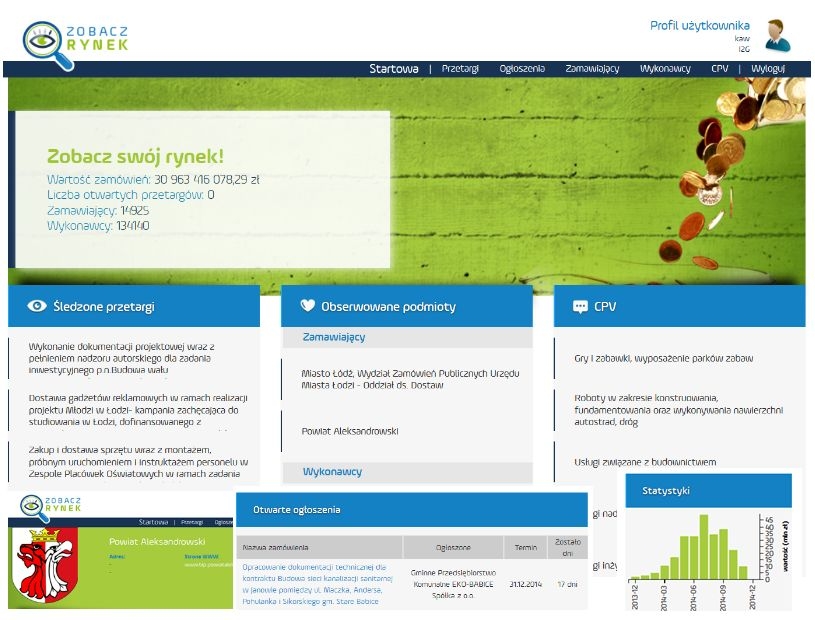Previous year's Nominees

The portal zobaczrynek.pl (literally spot your market) allows to discover knowledge about public contracts in Poland, particularly about the stakeholders – both contracting authorities and contractors. Through linking bidders, authorities, contracts, notices and procurement vocabulary looking for information is as simple as browsing the Web. The portal is designed both for desktop computers and mobile devices.
Contracting authorities are obliged by law to publish notices in a central bulletin. Hence, main source of data are XML files made available by Public Procurement Office in Poland. In the paper [1] we have presented a conversion process of public contracts notices from XML files to RDF triples. We are sticking to the Public Contracts Ontology [2], a standard making our solution universal.
Although relational solutions would be more efficient, expressing data in triples offers far greater flexibility. All access to data is handled via wrappers around SPARQL queries, from display of single entities through summary statistics to analytical tasks for discovering hidden patterns and relations between entities. Such approach also opens new opportunities with regard to enriching original data. The graph-based representation makes it possible to analyse various kinds of relations between market players. Detection of potential anomalies is empowered with suitable data representation from the beginning, i.e. we naturally represent networks of organisations. Several kinds of analysis are facilitated, e.g. prediction of number of bidders, associations among bidders, clustering of contracts. Official government bodies and journalists are among interested entities. [3]
The portal is not marketed as linked-data-based. The focus was on visually pleasing design making access to linked data transparent, just like browsing experience. In fact, linked data is hidden under the hood but we do take advantage of this. Data is more comprehensible for the owners of small companies who wish to focus on business rather than spend too much time on searching for offers.
It offers more than competitor’s systems presenting public contracts in Poland by the way it handles relations between contracting authorities, bidders and their topics of interest expressed by CPV. The linked data approach has several advantages over classical databases: navigation between data and enrichment of possessed datasets by linking to external information. It allows new application areas for enterprise like semantic search for offers and precise matching of tenders to interested contractors.
Some network effects can be observed. The growth related to the portal can be observed in several dimensions. First, number of users of the application: the more people use the portal, the more data can be verified, and again, the better quality of data, the bigger willingness to use the portal. Second, number of external sources: each new source can significantly increase interest in the portal. Third, extending to other countries: as the data model is based on a standard Public Contracts Ontology it can work with any data compatible with this ontology. Contractors could then be interested in offers from other countries as well. It is important to notice that the portal is not a general purpose linked data application. Nevertheless, the platform can be easily extended with new data. Changes in data model are quite straightforward, as it is based on triples, but in order for new data to be reflected, changes in user interface have also to be implemented.
From technological point of view the portal is at technology readiness level 8, i.e. actual system completed and qualified through test and demonstration. The portal is online, fed with real data. The solution is based on enterprise framework. At the heart of data processing we use stable technology - Virtuoso Open Source 7.1. Volume of data is roughly 30 million triples yearly and for demonstration purposes we keep data since 2013.
The portal is based on open standards as much as possible. XML is an initial data source. Raw data is converted into RDF/Turtle. Java/Spring framework is used for application development, which itself is deployed in Tomcat 7.x. HTML5 and CSS has been used (along with Bootstrap) to develop front-end.
Detailed description of the interface as well as the supported features is contained in the attached presentation. There are also two supplementing documents showing research challenges related to data model and analytical processing.
Demo
You can test the application at http://zobaczrynek.pl/. Please provide the following credentials: test:sema15VIE
Disclaimer: the application is currently available only in Polish. As it contains Polish texts it was no use to translate the interface.
Contact
I2G Ltd.
Krzysztof Węcel (Krzysztof.wecel@i2g.pl)
[1] K. Węcel, Public Procurement in Linked Open Data Paradigm (attached)
[2] https://github.com/opendatacz/public-contracts-ontology
[3] V. Svátek, J. Mynarz, K. Węcel, J. Klímek, T. Knap, M. Necaský, Linked Open Data for Public Procurement (attached)